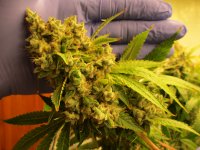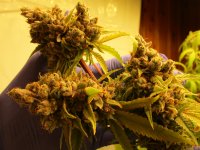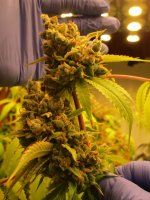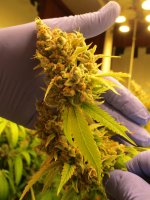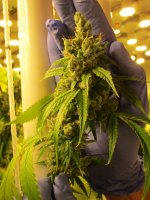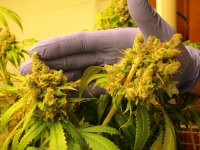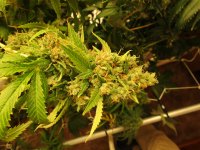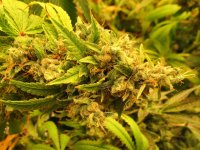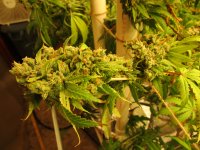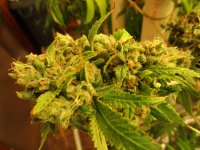You are using an out of date browser. It may not display this or other websites correctly.
You should upgrade or use an alternative browser.
You should upgrade or use an alternative browser.
Blue Star OG pheno hunt, PPK style
- Thread starter greyfader
- Start date
today marks 72 days of flowering. at 9 weeks i took another set of test flowers, dried and smoked them with my wife. we decided that #6 is the winner. it has a nice citrus fuel taste up front with a floral perfume back. very pleasant and smooth taste and smoke.
but the real story of this one is the potency. #6 and #4 both have great potency with #6 being the most potent. all the other phenos had good potency. but these 2 are about as potent as it gets.
i use a pipe with a small bowl to test with. it is about the same size as a thimble. 2 small hits and i got an invigorating, stimulating, focused high that lasted for several hours. it has a great pain-relieving effect as well.
#6 also produces well-shaped, dense flowers and produced well.
i am going to do a run with it immediately as soon as i get these plants down and change the pool configuration to one plant each. i want to see how big they can get.
some are almost done and a few will be done by the end of the week. i'm seeing a lot of opaque trichs now.
please remember, when looking at these pics, that few of them are terminal flowers. because of medical issues i had to veg them longer than i wanted and had to trim the entire canopy back like a hedge to keep them out of the lights.
these plants went into the system on april 9 and today is july 30 so this is 15 weeks these plants have been in the system. during this period absolutely no solution was removed and no changeouts occurred. this growth was accomplished using solution input only.
this is a closed-loop, recirculating system.
also, this grow was done using an 8 hour flowering period with 16 hours of darkness.
i delivered an average of 1200 umols of light for 8 hours which produced an average daily light integral of about 35 moles per day.
just a few pics of flowers at random and then the winner, #6. i will start taking them down one at a time now.
but the real story of this one is the potency. #6 and #4 both have great potency with #6 being the most potent. all the other phenos had good potency. but these 2 are about as potent as it gets.
i use a pipe with a small bowl to test with. it is about the same size as a thimble. 2 small hits and i got an invigorating, stimulating, focused high that lasted for several hours. it has a great pain-relieving effect as well.
#6 also produces well-shaped, dense flowers and produced well.
i am going to do a run with it immediately as soon as i get these plants down and change the pool configuration to one plant each. i want to see how big they can get.
some are almost done and a few will be done by the end of the week. i'm seeing a lot of opaque trichs now.
please remember, when looking at these pics, that few of them are terminal flowers. because of medical issues i had to veg them longer than i wanted and had to trim the entire canopy back like a hedge to keep them out of the lights.
these plants went into the system on april 9 and today is july 30 so this is 15 weeks these plants have been in the system. during this period absolutely no solution was removed and no changeouts occurred. this growth was accomplished using solution input only.
this is a closed-loop, recirculating system.
also, this grow was done using an 8 hour flowering period with 16 hours of darkness.
i delivered an average of 1200 umols of light for 8 hours which produced an average daily light integral of about 35 moles per day.
just a few pics of flowers at random and then the winner, #6. i will start taking them down one at a time now.
Attachments
Very nice looking light, i especially like the possibility of just adding incandesant seamlessly. Its pretty much the only light tweak i havent tried yet.hey buddy! sorry it has taken me so long to respond. i've had some medical issues to deal with.
rather than trying to answer your questions one by one i'll just ramble for a while in buckshot fashion and hope i hit all the targets.
since leaving oregon in late 2018 i have only used leds. but i have never bought a manufactured light. the reasons are that i think they are general-purpose lights designed to get you through both veg and flower and therefore compromises and not ideal. and too expensive. you know me, i'm a cheap bastard!
the general diode arrangement seems to be a combination of 3000k and 5000k phosphor-coated "white" leds. the phosphor coating method of producing "white light" starts with a blue diode and then coats it to achieve the color temperature. this makes all such diodes very strong in the blue range to start with. i think this biases the blue/red ratio too much towards blue overall for an ideal flower extension ratio. which is tied to the red/far-red elongation response. from my own experience, my led flowers are potent and terpene-heavy but don't get as large as my hps flowers did.
this ratio can be corrected by adding more dark red, far-red, and infrared. but you would only want to do this ratio offsetting during flower because in veg it would make the plants stretch too much.
conversely, a heavily blue-weighted spectrum makes for compact, sturdy plants by suppressing the elongation response. this produces tighter node spacing and more shoots.
this is why the ideal color temp for veg is 5000k/6500k.
the usual ratio of most manufactured led lights is 2/1 3000k to 5000k. then they use a few 660nm dark reds, typically less than 10% of total diode count, and maybe throw in a few 750nm range far-red just because dr bugbee mentions them online.
there are a few manufacturers making tunable lights but they are very expensive.
i've been experimenting with cheap household-type screw-in bulbs. 2700k and 5000k in various combinations and ratios. in this grow i'm using only 5000k up the end of week two of flower and then i'll switch them all out to 2700k bulbs supplemented with cheap appliance-type incandescents.
by using the 2700k only i'm reducing the overall blue/red ratio as far as possible with these phosphor-coated diodes.
my lights are being operated at 1008 watts each by using 72 14-watt bulbs.
when i switch them out with the 2700k bulbs i'll use 60 for 840 watts and then 6 25-watt incandescents for another 150 watts making it 990 watts total consumption.
incandescents have more of their output in the red/dark-red range than the sun. and far more than a hps. they have some uva. they have a controllable infrared input by using lower wattage than using leds in conjunction with hps.
i think the infrared is needed in small amounts and leds are devoid of infrared unless you put in 850nm or above diodes to produce it. infrared penetrates leaf tissue and heats the leaves internally which i think drives up the metabolic rate.
infrared radiation does not heat the medium it travels through but rather the target it hits.
on leds and metabolic rate tied to light flow, i think leds, because they are multi-point with very wide beam angles, typically 120 degrees, have a much higher light-to-shade ratio than a single-point source.
this must be driving a higher metabolic rate at the same apparent par spot readings that you get with hps.
this is coupled with the fact that approximately 30% of the electrical energy used to power a hps goes straight to heat not par light so a 1000-watt led is delivering much more energy in the par range.
this is why a 700-watt led delivers the same approx par as the 1000-watt hps.
so all this is tied to feed strength because the equivalent led is driving the metabolic rate much higher.
and tied to ambient heat as well. heat is the second most powerful regulator of metabolism after light. with leds you should run the whole room at 84-86f lights on.
i'm gonna stop for now but i'll be back!
As for tunable lights: there are a few out there but generally not so impressive. Ive done a couple DIY with led components; its a bit more efficient (the ac-dc converters in led lightbulbs are quite shitty for that), its dimmable and doesnt require changing any bulbs, you can set it up with switches or just change the way you feed the leds thru connectors/wagos. Also 100lums per watt for cold white led is very low, checking the spectrum you posted here or in the other thread it looks like they are 70cri: almost no red in their spectrum. If power consumption or cooling becomes an issue there are other ways (very easy building) to get similar or better performance with dedicated led components.
Bridgelux has a very nice strip with 2 separate channels: 5000k /2700k both in 90cri. The CRI in this case means that the spectrum has more red/far red in it (its actually about how the light renders colors but the end effect is more red). I built this little light out of these bridgelux vesta strips:


Its a bit hard to see but each line of light is actually 2 rows of leds, one cold white one warm white. The way i set it up was so that theres one circuit in the centre, one in the sides, so you can control the middle hotspot some what. Each of these circuits has its own dimable driver. Each circuit also have spectrum control, i diyed some switches that turn on cold white and warm white individually. So you can send down full power thru cold or warm white, or activate both at half power for a sorta full cycle/better efficiency mode. On the centre circuit i added some extra mono strips to add some deepreds. You could of course set it up so you could have individual drivers for each color but that means youd have to have much bigger drivers.
@greyfaderVery nice looking light, i especially like the possibility of just adding incandesant seamlessly. Its pretty much the only light tweak i havent tried yet.
As for tunable lights: there are a few out there but generally not so impressive. Ive done a couple DIY with led components; its a bit more efficient (the ac-dc converters in led lightbulbs are quite shitty for that), its dimmable and doesnt require changing any bulbs, you can set it up with switches or just change the way you feed the leds thru connectors/wagos. Also 100lums per watt for cold white led is very low, checking the spectrum you posted here or in the other thread it looks like they are 70cri: almost no red in their spectrum. If power consumption or cooling becomes an issue there are other ways (very easy building) to get similar or better performance with dedicated led components.
Bridgelux has a very nice strip with 2 separate channels: 5000k /2700k both in 90cri. The CRI in this case means that the spectrum has more red/far red in it (its actually about how the light renders colors but the end effect is more red). I built this little light out of these bridgelux vesta strips: View attachment 18891076 View attachment 18891077
Its a bit hard to see but each line of light is actually 2 rows of leds, one cold white one warm white. The way i set it up was so that theres one circuit in the centre, one in the sides, so you can control the middle hotspot some what. Each of these circuits has its own dimable driver. Each circuit also have spectrum control, i diyed some switches that turn on cold white and warm white individually. So you can send down full power thru cold or warm white, or activate both at half power for a sorta full cycle/better efficiency mode. On the centre circuit i added some extra mono strips to add some deepreds. You could of course set it up so you could have individual drivers for each color but that means youd have to have much bigger drivers.
These are the blux Vestas i talked to you about over at the other thread
Veg/full cycle/flower spectrum, individually switchable both in the centre and the sides. And separate diming for centre and perifery so you can dial in perfectly even coverage.
About 250 euros at the time but pre inflation. Efficiency 2.4-2.6 ppf/w depending on if youre using one or both channels at the same time. 300w, 3x3 coverage. But youd have to beef it up a bit if you wanna get to 1200 ppfd...
This thread is absolutely Jam packed with gold!
I've recently made the switch to LEDs from HPS and CMH ( Ive chosen to run a CMH with my LEDs in winter)
After reading this I am going to experiment with the incandescent trick on my next run.
Although I believe I have built my lights from what I believe to be the very best manufacturer LED strips available ( Grow Light Australia)
If I could do it again I would follow your example of individual house hold bulbs .
What would be your recommendation for supplemental deep red/IR light per square foot?
Cheers
I've recently made the switch to LEDs from HPS and CMH ( Ive chosen to run a CMH with my LEDs in winter)
After reading this I am going to experiment with the incandescent trick on my next run.
Although I believe I have built my lights from what I believe to be the very best manufacturer LED strips available ( Grow Light Australia)
If I could do it again I would follow your example of individual house hold bulbs .
What would be your recommendation for supplemental deep red/IR light per square foot?
Cheers

